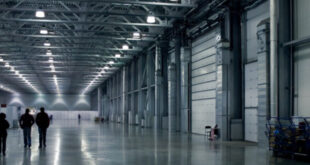Large industrial projects are having to move away from urban areas
The Inland Empire isn’t the only market that is running out of space large enough to accommodate mega warehouse-distribution centers. The trend, strongest in the Inland region, is happening in five of the United States’ industrial markets, according to a report by CBRE.
Industrial developers throughout the United States are having to move further away from their major metropolitan areas to find enough space to build warehouse-distribution facilities, and nowhere is that trend more pronounced than in the Inland Empire.
The Inland region currently leads all U.S. industrial markets with 60 percent rent growth year-over-year for “big-box” projects, according to Big-Box Industrial Development Pushes Out from Major U.S. Industrial Centers, a recent study by CBRE
That, combined with a one percent vacancy rate, reflects the “robust demand” for industrial space in the region sometimes called the warehouse of the western United States, the report declares.
But that robust demand is moving east, away from the Inland Empire’s core urban market in and around Ontario International Airport. That trend began years ago, but it might be moving faster now than it ever has.
During the first quarter of this year, there was more than 25 million square feet of big-box industrial projects under construction in Riverside and San Bernardino counties.
Thirty nine of those were an average of 18 miles from the Inland Empire core, compared with 13 big-box projects that were an average of 13 miles way from the region’s core in 2017.
In addition, two proposed projects would bring a little more than three million square feet of additional logistics space to Banning and Beaumont in the San Gorgonio Pass in Riverside County. Also known as Banning Pass, San Gorgonio Pass encompasses part of Interstate 10 and is a major transportation corridor from greater Los Angeles into the Coachella Valley.
The High Desert, will be one of the most active outer-core markets for development in coming years, mostly because land is 50 percent to 75 percent cheaper per square foot than in the Inland Empire core, the report predicts.
The trend of larger industrial projects being built well outside of their core urban market is happening more in the Inland region than in any other major industrial market, but it’s happening in other markets.
The Dallas-Ft. Worth market had eight major industrial projects built 25 miles from its urban core. This year, that number is expected to hit 46, CBRE reports.
In Chicago, those numbers went from 30 projects in 2017 to an anticipated 37 projects this year, a relatively modest increase.
But in two of the country’s largest remaining industrial markets, Atlanta and New Jersey/New York/Pennsylvania, those numbers were much higher: from 13 projects to an expected 48 in Atlanta and 24 projects to an anticipated 63 in the tri-state market.
In the case of the Inland Empire, its core market – the west end – is running out of parcels large enough, and affordable enough, to accommodated big-box project, said James Breeze, senior Director and global head of industrial and logistics research for CBRE.
But companies still want to put their logistics operations in the Inland Empire because of its large population base and proximity to the ports in Los Angele and Long Beach.
That trend has been happening for about 20 years, but it’s been accelerated during the last several years because of the increase in e-commerce caused by the pandemic, according to Breeze.
“The west end of the Inland Empire is an infill market now, a lot like Los Angeles County, said Breeze, a co-author of the the report, which defines big-box as a development of at least 200,000 square feet.
In the Inland Empire, the term applies to industrial projects at least 500,000 square feet.
“As far as new markets, you’re looking at Banning, Beaumont and the High Desert,” Breeze said. “Those markets are farther away from the ports, but if you’re a corporation and you have to be in the Inland Empire, another 30 miles doesn’t mean very much.”
There’s no question that industrial development in the two-county region has been moving east for some time, and that COVID-19 accelerated that trend, said Paul Earnhart, senior vice president with Lee & Associates Ontario and a veteran industrial broker in the Inland Empire.
“Things are definitely moving east, but I’ve always been a little skeptical of the High Desert, because it’s so difficult for the trucks to get up there,” Earnhart said. “I know there are some projects happening up there, especially in and around Victorville, but I don’t know how long that will last. It’s too tough to get up and down Interstate 15.”
The Central Valley, a 450-mile stretch in central California better known for agriculture, is starting to attract industrial development, according to Earnhart, who has been negotiating industrial deals in the Inland Empire for more than 30 years.
“I was up there recently and it reminded me of the Ontario market, there was so much ‘spec’ development going on,” he said.
 IE Business Daily Business news for the Inland Empire.
IE Business Daily Business news for the Inland Empire.



Although this is happening at the moment, I cannot see this continuing. With the new Climate-Reporting Regulations being issued by the SEC for publicly traded companies, companies won’t be able to get away with using farm land outside the suburbs with no mass transit nearby to build their new buildings. This complete disregard for Scope 1, Scope 2 and Scope 3 (upstream and downstream) emissions, inclusive of Embodied Carbon emissions will eventually stop. When the Scope 3 employee commute and truck emissions become the issue of the publicly traded tenant and that of the LL, suddenly these pieces of real estate in the middle of nowhere will no longer make sense. I certainly wish the large brokerage houses who have committed to get to Net Zero by 2040 will make every effort to communicate these concerns to their publicly traded corporate clients, otherwise the clients will eventually get frustrated when they are hit with Carbon Taxes at some point in the future.